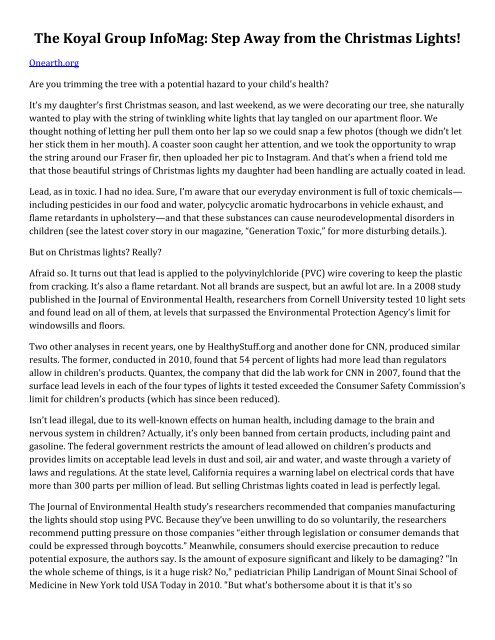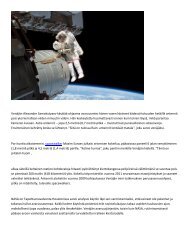The Koyal Group InfoMag: Step Away from the Christmas Lights!
Create successful ePaper yourself
Turn your PDF publications into a flip-book with our unique Google optimized e-Paper software.
<strong>The</strong> <strong>Koyal</strong> <strong>Group</strong> <strong>InfoMag</strong>: <strong>Step</strong> <strong>Away</strong> <strong>from</strong> <strong>the</strong> <strong>Christmas</strong> <strong>Lights</strong>!<br />
Onearth.org<br />
Are you trimming <strong>the</strong> tree with a potential hazard to your child's health?<br />
It’s my daughter’s first <strong>Christmas</strong> season, and last weekend, as we were decorating our tree, she naturally<br />
wanted to play with <strong>the</strong> string of twinkling white lights that lay tangled on our apartment floor. We<br />
thought nothing of letting her pull <strong>the</strong>m onto her lap so we could snap a few photos (though we didn’t let<br />
her stick <strong>the</strong>m in her mouth). A coaster soon caught her attention, and we took <strong>the</strong> opportunity to wrap<br />
<strong>the</strong> string around our Fraser fir, <strong>the</strong>n uploaded her pic to Instagram. And that’s when a friend told me<br />
that those beautiful strings of <strong>Christmas</strong> lights my daughter had been handling are actually coated in lead.<br />
Lead, as in toxic. I had no idea. Sure, I’m aware that our everyday environment is full of toxic chemicals—<br />
including pesticides in our food and water, polycyclic aromatic hydrocarbons in vehicle exhaust, and<br />
flame retardants in upholstery—and that <strong>the</strong>se substances can cause neurodevelopmental disorders in<br />
children (see <strong>the</strong> latest cover story in our magazine, “Generation Toxic,” for more disturbing details.).<br />
But on <strong>Christmas</strong> lights? Really?<br />
Afraid so. It turns out that lead is applied to <strong>the</strong> polyvinylchloride (PVC) wire covering to keep <strong>the</strong> plastic<br />
<strong>from</strong> cracking. It’s also a flame retardant. Not all brands are suspect, but an awful lot are. In a 2008 study<br />
published in <strong>the</strong> Journal of Environmental Health, researchers <strong>from</strong> Cornell University tested 10 light sets<br />
and found lead on all of <strong>the</strong>m, at levels that surpassed <strong>the</strong> Environmental Protection Agency’s limit for<br />
windowsills and floors.<br />
Two o<strong>the</strong>r analyses in recent years, one by HealthyStuff.org and ano<strong>the</strong>r done for CNN, produced similar<br />
results. <strong>The</strong> former, conducted in 2010, found that 54 percent of lights had more lead than regulators<br />
allow in children’s products. Quantex, <strong>the</strong> company that did <strong>the</strong> lab work for CNN in 2007, found that <strong>the</strong><br />
surface lead levels in each of <strong>the</strong> four types of lights it tested exceeded <strong>the</strong> Consumer Safety Commission’s<br />
limit for children’s products (which has since been reduced).<br />
Isn’t lead illegal, due to its well-known effects on human health, including damage to <strong>the</strong> brain and<br />
nervous system in children? Actually, it’s only been banned <strong>from</strong> certain products, including paint and<br />
gasoline. <strong>The</strong> federal government restricts <strong>the</strong> amount of lead allowed on children’s products and<br />
provides limits on acceptable lead levels in dust and soil, air and water, and waste through a variety of<br />
laws and regulations. At <strong>the</strong> state level, California requires a warning label on electrical cords that have<br />
more than 300 parts per million of lead. But selling <strong>Christmas</strong> lights coated in lead is perfectly legal.<br />
<strong>The</strong> Journal of Environmental Health study’s researchers recommended that companies manufacturing<br />
<strong>the</strong> lights should stop using PVC. Because <strong>the</strong>y’ve been unwilling to do so voluntarily, <strong>the</strong> researchers<br />
recommend putting pressure on those companies “ei<strong>the</strong>r through legislation or consumer demands that<br />
could be expressed through boycotts.” Meanwhile, consumers should exercise precaution to reduce<br />
potential exposure, <strong>the</strong> authors say. Is <strong>the</strong> amount of exposure significant and likely to be damaging? "In<br />
<strong>the</strong> whole scheme of things, is it a huge risk? No," pediatrician Philip Landrigan of Mount Sinai School of<br />
Medicine in New York told USA Today in 2010. "But what's bo<strong>the</strong>rsome about it is that it's so
unnecessary, and that safer substitutes do exist." <strong>Christmas</strong> lights sold at IKEA, for example, are held to a<br />
stricter European standard, meaning less lead (though <strong>the</strong>re can still be some).<br />
Last year, science journalist Emily Willingham poked a bit of fun at <strong>the</strong> concern over toxic <strong>Christmas</strong><br />
lights in her blog for Forbes. Yes, she acknowledged, studies show a potential problem. “What a firstworld<br />
response, though,” she writes, “to make a special trip to IKEA, which always seems so far away, in<br />
your gas-burning automobile to buy precious, lead-free <strong>Christmas</strong> lights to plug in and power up thanks<br />
to your friendly neighborhood coal-burning power plant.”<br />
Fair points, especially when <strong>the</strong>re’s an easier way to protect yourself and your kids: washing hands with<br />
soap and water. Lead isn’t readily absorbed through <strong>the</strong> skin, so <strong>the</strong> main worry is that people will get it<br />
on <strong>the</strong>ir hands, <strong>the</strong>n put <strong>the</strong>ir fingers in <strong>the</strong>ir mouths. Washing up after handling <strong>the</strong> lights should remove<br />
that risk, says Joseph Laquatra, a professor at Cornell's College of Human Ecology who led <strong>the</strong> Journal of<br />
Environmental Health study.<br />
So now that I know about <strong>the</strong> lead on my lights, am I going to leave <strong>the</strong>m off my fir? No. But I’ll keep my<br />
daughter away <strong>from</strong> <strong>the</strong>m <strong>from</strong> now on, and if I need to replace <strong>the</strong>m in <strong>the</strong> future, I’m definitely looking<br />
for lead-free options. And hey, if anyone out <strong>the</strong>re is looking to buy me an appropriate stocking stuffer<br />
this year…




